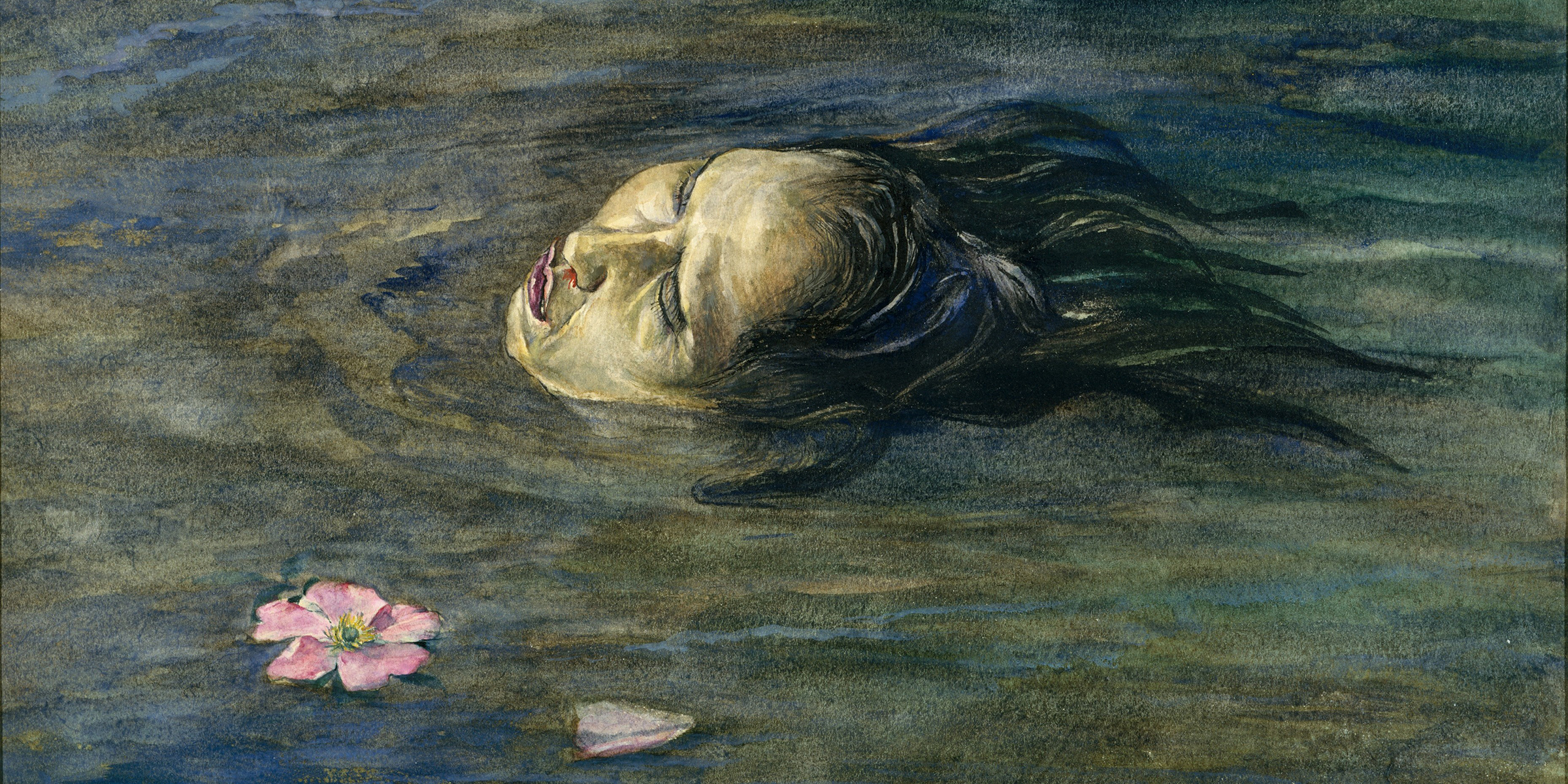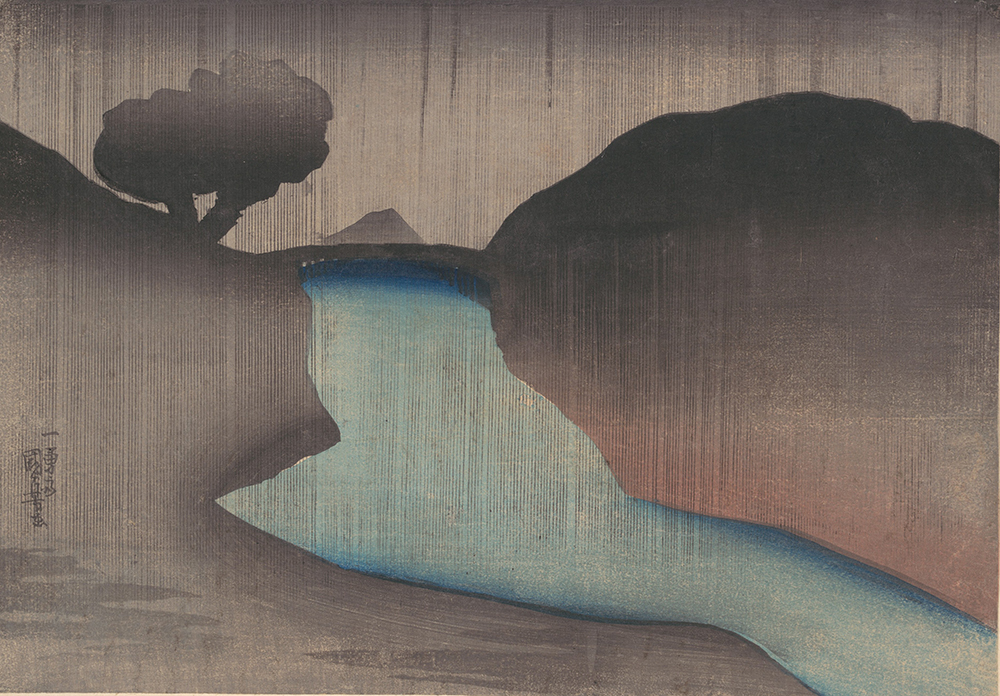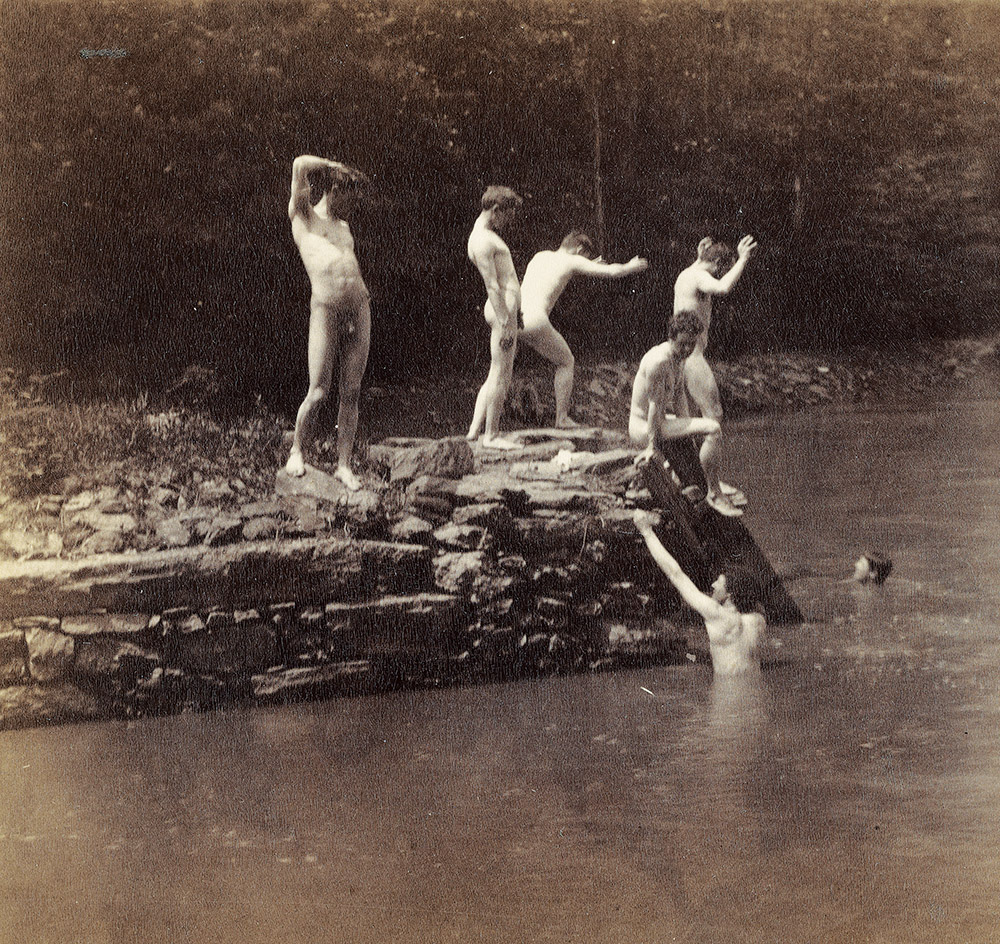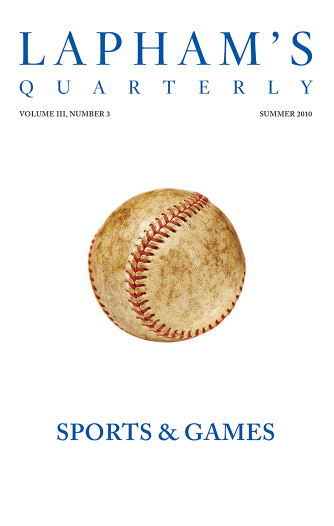There’s plenty of water in the universe without life, but nowhere is there life without water.
—Sylvia Alice Earle, 1995
Waterfall on Mont-Morency, by Robert Scott Duncanson, 1864. © Smithsonian American Art Museum, Washington, DC / Art Resource, NY.
When the poor and needy seek water, and there is none, and their tongue fails for thirst, I the Lord will hear them, I the God of Israel will not forsake them. I will open rivers in high places, and fountains in the midst of the valleys: I will make the wilderness a pool of water, and the dry land springs of water.
—Book of Isaiah
Through the Jordan Rift Valley flows its river, named from the Hebrew verb for “go down.” The valley is the result of a shattering that separated the Arabian Peninsula from Africa millions of years ago, motions that riled the land aboveground and below, creating a variety of wrinkles, fissures, and bubbles, and a certain whimsicality in water supplies. A number of springs are hot and infused with minerals. Dry streambeds, called wadis, flood after storms. The foundation stories of the Hebrew Bible—by far the fullest written source about early civilization in the region—support archaeological findings in depicting a local political economy that was decentralized, partly nomadic, and based on small-scale crops and herds. This is what we would expect where water drove not accumulated power and wealth but improvisation for survival.
In contrast, abundant, readily usable running water shaped earlier civilizations of the Near East. There were dikes, canals, and sluices to keep the land on a riverbank fertile while sparing it from destructive flooding. The most valuable tracts could then be rationally apportioned, and the labor for exploiting them could be efficiently assigned. Organizing the flow above and the dirt below lifted farming above subsistence levels, which meant surplus yields to be shared with rulers or taxed and traded in regulated markets, and often transported by navigators on the river itself. Even when water was not substantially controllable, it proved to be at least understandable—and so exploitable to tremendous effect. In Egypt a calendar linked the Nile’s yearly fertilizing floods to astronomical cycles, establishing the magic of food production and the glories of plenty as a function of the administrative and professional classes, with the pharaohs at the apex claiming absolute rule by virtue of their ability to intermediate with the gods and grant or withhold water’s life-giving power.
But the Jordan could not offer Canaanite farmers and herders what the Nile would have. The major river in the small polygon of the Holy Land is only about two hundred miles long and falls fast and steep over much of its length. It is more apt to erode the soil than to leave alluvial riches, so some forests were allowed to remain on its banks. Its stretches of white water have always limited navigation; the outlet, anyway, is not the Mediterranean but the Dead Sea, a corrosive salt lake. Neither Jerusalem nor Samaria, the capitals of the divided kingdom known to history, was built on its banks.
Over many miles and many centuries, the only available water technology was wells, which gave rise to consequential Old Testament narratives. Take, for example, the first encounter of Jacob, the progenitor of the Twelve Tribes of Israel, with Rachel, who was to be his favorite wife and the mother of Joseph and Benjamin. Rachel (from the Hebrew word for “ewe”) is tending her flock—her lone deployment testifies to her family’s poverty and vulnerability—and she depends on a crowd of male shepherds to shift the stone cover of a well; it’s implied how much fun they had in their encounters with her, and how little fun she had. But now her cousin Jacob arrives from the wilderness and moves the stone single-handedly, rendering her safe and respected. Later, during the time of Roman waterworks starting in the first century bc, wells were still momentous. In the biblical book of John, Jesus is resting next to “Jacob’s Well” during a journey, but it is now a Samaritan water source; he ends up having a challenging and mutually revelatory conversation with the Samaritan woman he has asked for a drink in defiance of the religious rules that made Samaritans untouchable to Jews.
But the most celebrated water in ancient Palestine did not come from wells; it rose in the natural springs that fed enduring streams and rivers and communal reservoirs. In the Old Testament, flowing or “living” water stands for God’s faithful and lasting provision for his people. From the opposite direction, from above, God’s presence is announced by powerful, dramatic, life-giving storms. The spring (or fountain) and the rain surrounded the chosen people with verdure—but only, according to a biblical refrain for God’s interventions, “at the right time.”
The rewards of faith unimaginably surpassed any material need. Deliverance was imagined in a climactic complex of images: pure, abundant, lifesaving water encountered amid dryness, a “grace” or free gift from a God reaching out to dying humankind, not only saving life now but lifting it on high forever. Instead of well water to be hauled laboriously out, Jesus promises the Samaritan woman water that is active on its own, literally transcendent, “springing up into everlasting life.” That is, God will come to her with salvation—if only she could be ready for it.
These ideas of peril, hope, and deliverance had geological and meteorological origins. Because large-scale irrigation works were not possible in Palestine—as they were for the Egyptians and for the Babylonians, who exploited the Tigris and Euphrates—the locals never experienced a human-engineered transformation of their lives toward collective wealth and strong government. They had water sources, including rain, whose origins—underground, in the atmosphere, in distant mountains—they couldn’t see and whose intermittent failure they couldn’t understand.
Contrasting experiences of water technology were rare. King Hezekiah—who, with the exception of his great-grandson Josiah, was the only great biblical king after Solomon—reportedly channeled water into Jerusalem from a spring as a precaution against a siege by the Assyrians. The Siloam Tunnel, as it is known to archaeologists, was an ambitious and ingenious project for the time and the region, but nothing else on even that modest scale was apparently undertaken in the area until imperialist Greek builders arrived in the late fourth century bc, after the conquests of Alexander the Great in Asia and the Middle East. Then, several centuries later, these were followed by the Romans with their gigantic sewers and aqueducts.

The Strange Thing Little Kiosai Saw in the River (detail), by John La Farge, 1897. The Metropolitan Museum of Art, Rogers Fund, 1917.
The unpredictability of water early on must have fed into the idea of a single God who sustained his people with inexplicable love but also often became very angry. His anger, however, must be survivable; there had to be a reason that a people always vulnerable to drought and famine and foreign conquest were still there. But pessimism and irony as well as fearful reverence became inescapable for a group whose major river was good for little except as a landmark, whose biggest lake was useless for fishing or watering livestock and uninhabited on most of its shores.
Perhaps most fundamentally, this was a landscape on which to develop a fine contempt for steep human authority—not only for Nebuchadnezzar and the pharaoh, with their hubristic and brittle material power, but also for the native hierarchy, that long succession of royal courts, with their self-defeating foreign alliances and spasms of useless idolatry. Salvation was, self-evidently, not pending from formal government, not even from that of the one God’s own priests and their acolytes. Instead, perhaps it would come from the Lord who dwelt on high and offered the untamed weather, which brought either sudden rescue or slow death.
Accordingly, Judaism yielded in abundance that freelance popular leader, the prophet, who communicated with God in the wilderness (the Hebrew word for which means “place of speaking”) and was a master of these mysterious places’ water. The prophet had vague prototypes through the rest of the Middle East in subservient indoor officials such as the scribe, courtier, priest, and diplomat, but Hebrew prophets could carry their power independently, in no small part because they testified to the divine liquid secrets of life and death. Moses the holy magician first punishes the Egyptians by turning the Nile into blood. He leads the Hebrew slaves out of bondage, parting the Red Sea to let them pass through and then bringing the waters back together to drown Pharaoh’s pursuing army. He keeps the Hebrews alive for forty years of wandering in the wilderness; they survive on the manna (from the Aramaic for “What is it?”) that forms like morning dew. In an emergency, he strikes a rock with his staff and water pours out.
Other examples of prophetic affinity with water abound. Elijah, at war with the wicked and worldly regime of King Ahab of Israel, flees by God’s command and camps out in a ravine, near a stream he can drink from, where ravens will feed him regularly. The stream dries up during a drought that punishes Israel for the pagan worship of Baal, a purported weather god. Elijah proceeds to a pagan town and miraculously renews the grain supply of the widow who takes him in, and later he even raises her son from the dead. In a climactic confrontation with the priests of Baal, he challenges them to light by prayer alone the fire to consume a sacrifice. After hours of their useless prancing and praying and bloody self-mutilation, he soaks the altar with water and invokes an annihilating fire onto it from the sky.
Amos, a prophet who passionately opposes inequality and corruption, reports of God commanding the people to “let justice roll like waters, and righteousness like an ever-flowing stream,” in place of empty Temple ritual. His belief in God’s indifference to festivals, sacrifices, and liturgical music—and his invocation of dramatically flowing water that heals social wrongs—may reflect an observation that there was no causal relationship between religious performances in the Temple and communal well-being, whereas plentiful water could visibly restore the economy.
Early during the first century, the sort of unofficial resistant Judaism we read about in the Old Testament’s books of the Prophets, with its emphasis on independent faith and moral purity—as opposed to inherited and institutional position—culminated in the cult of baptism, with John surviving on locusts and wild honey and dipping penitents in the Jordan, so that the swift-flowing water would carry their sin away to an unknown place.
In fact, all the prophets—and the stories of their persecutions back this up—had a talent for uprooting and overturning what was overgrown and ethically petrified. According to the Bible, a Canaanite-style prophet could, like Moses or Daniel or Jonah, come from a relative nowhere and confront the most powerful ruler in the world. In the face of the prophets’ influence, modern secular notions of prophecy (inspired foretelling) and the prophetic (usually of someone “speaking truth to power”) are woefully narrow. The post-Solomonic kings had nothing on prophets, many of whom were ingenious authors commanding words that flowed of their own accord. An index of the Greek New Testament reveals that, at least during the time of Jesus and in the decades after, the books of the Prophets were rampantly quoted in popular discourse—Isaiah was a particularly lively inspirer of the Jesus movement—whereas little spontaneous interest showed in the reams of biblical law (outside of the Ten Commandments) or the biblical histories of the royal houses.
Biblical law was much concerned with blood sacrifice, which from the seventh century bc was restricted to the Temple. The flow of bodily fluid there tended to be covered over with euphemism, or with sheer silence, in Jewish scripture—as were menstruation, sex, and childbirth. But the fear, the disgust, the smells, the whole chaotic scene is easily inferred: in the Aeneid, that great Roman national epic of the classical era, a contestant in a footrace slips in a slime of cattle blood and dung from the sacrifices that have inaugurated the games.
From a hygienic angle alone, the Temple must have been a particularly glaring iteration of the ancient metropolis’ broken promises. It was supposed to be safe for a people to live together within high walls. But ancient cities—even those with the most technologically advanced waterworks—were filthy, ideal for the spread of disease. The actual public cleansing facilities, such as the Roman bathhouses and the “healing” pool of Bethesda in Jerusalem, were likely rich sources of infection, offering death under the auspices of purification. It was, in fact, better to stay in the village and bathe from a basin of well water or with oil and a scraper.
Attempts to institutionalize the defiant vision of holiness and wholeness—in which humankind was washed, purified, and sanctified by God alone, absent the needs of the urban hierarchy, naturally and for no earthly price—can be traced from ascetic Jewish sectarian movements starting in the second and first centuries bc through to Christian anchoritic and monastic practices and beyond. A deep irony, of course, is that this attitude itself was a significant instigator of conflict. Dedicated idealists often cause catastrophes. No matter how nurturing, cleansing, or moralistic the vision of water as freedom and life, it is not usually water that ends up flowing from it but blood.
All this shouldn’t be particularly surprising if we consider the fate of a modern world shaped by Jewish and Christian thought and practice, from which we have inherited so much contradiction: a passionate longing for an all-powerful life force that confers individual freedom and authority and yet demands emotional and intellectual surrender; that prescribes both sublime self-acceptance and the most excruciating self-annihilation. What more ideal imagery could exist for this ideology than the endlessness of water—what we dream of but can’t have?
What we do have is unending conflict. The ancient imperial cultures kept falling into obscure local backwardness; we just keep hurtling ahead, because in the contemporary West our crises are never, in essence, about some brittle hubristic tyrant but instead about all of us and the ridiculous pretensions we can accumulate together. We are forced to acknowledge, on a much larger stage, what human beings are: creatures of dust and ash, who, though made mostly of water, don’t flow esoterically but rather congeal in lumps under the rain. Prophets called for us to free ourselves of the tyranny of social strictures and ascend to the plane of pure thought. But what do we do once we stop slaughtering in the Temple to buy self-preservation and good fortune, and turn to some ethereal aspiration?
Augustine of Hippo tried in late antiquity to establish a contemplatively sublimated Christian community but found himself instead running a state-sponsored monastic group, preoccupied with doctrinal enforcement and real estate. Francis of Assisi—called the only man in history actually to have practiced Christianity—once forbade a follower to acquire a Psalter (a worship text based on the Psalms) because this would lead inevitably to the man’s sitting on a lofty chair and ordering someone else around. But the Franciscans did eventually acquire vast libraries and archives, and they do routinely give mundane orders. The hope for watery freedom hardens on the land.
I have spent years reading these stories, and I realize now how thoroughly I have lived them. Growing up in the American heartland of the twentieth century, I found myself on an extended, poignant prong of the West, where refugees of conscience and oppression had begun to settle a century and a half before, picturing freedom from want and fear and selfless service to the future, picturing in almost the same thought trim farmhouses and stylish buggies. My family was a fairly smooth continuation from all this. Some of our ancestors had evinced the searing antislavery sentiment typical of German settlers. We were now pious Methodists still honoring the sacrifices of the Great Depression, World War II, and the Korean War; but we were materialistic, too, and especially shamed by owning only an acre and a quarter.

Ochanomizu in the Rain, by Kuniyoshi, mid-nineteenth century. The Metropolitan Museum of Art, The Howard Mansfield Collection, purchase, Rogers Fund, 1936.
This was northwest Ohio, in the region of the former Black Swamp. Recognizing the value of the black earth underneath, settlers in the late nineteenth century had drained the swamp by digging some of the most extensive ditches in the world, and these now follow a grid of neat blacktop roads bordering fields of corn, wheat, and soybeans. Though we ourselves were not farmers—my father was a biology professor at the university in town—we had fields on three sides of our house beside the Dixie Highway. A channelized stretch of the Portage River—essentially a large ditch—was a quarter mile down the highway in one direction. About a half mile to the back of us, a ditch ran under a culvert, the Troll’s Bridge, so named by our rather desperate projection of folklore onto our landscape. The river and the ditches emptied so fast after heavy rains that you could seldom see any water in them, only grass on the sides and mud at the bottom.
Actual bodies of water in Wood County were quarries—thronged with swilling teenagers, a few of whom drowned—where gravel had been dug; slimy-bottomed ponds hollowed out for dirt to build highway overpasses and now infested with “swimmer’s itch” parasites from waterfowl; and the shallow pond in the university’s biology research and teaching woods beyond the Troll’s Bridge.
I fantasized about natural water dividing the land, and I hypnotized myself into certainty that the large spring puddle in the field behind our house was becoming a lake, fed by a waterfall from the heaping clouds that could be mountains. I anticipated the ditches overflowing into uncontrollable wetlands. I hounded my parents for visits to Lake Erie, though it was too polluted to swim in.
It was therefore thrilling that the family moved, when I was fifteen, to an apartment in the Wood County Historical Museum after my mother got a job managing the park around it. The complex comprised a sixty-room, mostly empty former poorhouse (now grandly styled a museum) and dozens of acres of gardens, forest, and fields interspersed with outbuildings. A road passed through the grounds beside disused reservoirs and through the forest, and crossed an iron bridge over a natural stretch of the Portage.
At one point during the late 1970s, farmers upstream from us sought permission to channelize the wild portions of the river. The project would make the Portage a ditch in its entirety. Amid the initial controversy, a fearsome farming mogul named Mr. Apple sent a hireling with a backhoe into the park one Sunday morning, and a stretch of one bank was churned into a massive brown batter before we knew what was happening. My parents called the sheriff and later founded Save the Old Portage, or STOP, recruiting my father’s university colleagues as well as downriver farmers who would get destructive flooding instead of lucrative drainage out of the channelization.
But economics barely figured in our initial campaign. Water mad as I was myself, I was surprised at how much love running water could evoke. Even I knew that, for example, trying to canoe here was silly, but in a publicity stunt, a professor and his young family steered and hauled their vessel through several miles of the low midsummer current and declared the experience inspiring. Hardened eyes wept over a Friends of the Earth film and its musical evocation of “clear, fragrant waters that rolled in the sun.” For display at the county fair, we took photos of misty and curving stretches of the Portage.
But the spirit of the wilderness—in the tradition of the biblical prophets we studied and sang about—is tricky in public life. Of course the spirit defies Pharaoh, the tyrant; Mr. Apple, the plutocrat; and the Army Corps of Engineers, with its hunger for pork barrel. But it also struggles to deal at all productively with county commissioners and courts, with its own governing entities, close at hand and theoretically under its control in an idealized commonwealth.
Spit not in the well; you may have to drink its water.
—French proverb,This problem is particularly acute when the object of contention is water. Americans have often pictured themselves, as the Israelites did, as settlers in a providentially well-watered and fertile land meant just for them. Canaan was going to be “flowing with milk and honey” for former slaves. North America was going to open glistening wet wildernesses to former peasants and urban throwaways. Much of precolonial North America was actually a network of beaver ponds, deep natural reservoirs that stabilized the soil and climate, and the earliest Europeans to penetrate many areas were beaver trappers.
Early explorers traveled by rivers and lakes and were awed by waterfalls. Settlements tended to run organically along waterways, which quickly came in for systematic exploitation. The Erie Canal, for instance, critically extended massive commodities trade into the West and made New York City rich. Iconic statesmen backed such “internal improvements” to facilitate sustainable commerce.
But there was also a long strain of American aspiration that had nothing to do directly with farming or trade but instead enthralled itself to the wild, tumultuous, and sprawling natural world. Such aspiration possessed Teddy Roosevelt, the first great statesman of conservation. Water in the national experience was, on the one hand, an indispensable resource for survival and development but, on the other, a symbol and the reality of decentralization, of freedom and spiritual independence.
The tension has been there from ancient times; our relationship to water has never really fit into our notion of an orderly society and body politic. In the whole of the Bible, so full of laws and strictures, I don’t find a single verse instructing the people how to protect and share water. And as the prophets came up short on detailed and practical ideas for the national renewal they envisioned, so too are the U.S. laws on water inadequate, a notorious hodgepodge; in some places they include the right to draw from a watercourse as much as you like simply because your ancestor homesteaded on the banks. Even in the twenty-first century, industrialists effectively have the right to poison the drinking water of millions, knowingly and for profit. That’s how little the EPA and other agencies are entitled to do in opposition, despite the Clean Water Act and other measures considered public health and conservation landmarks.
My parents and the other adults in STOP were caught in paradoxes many other water conservationists would recognize. They wanted to exercise community leadership, to affect practical control in a cause that was fundamentally antipolitical, that argued for the sanctity of a watercourse as nature had made it: free, untouchable, and transcendent, the landscape’s counterpart of the sanctified person, deeply beloved and eternally protected by God. Jesus and the prophets didn’t talk about “living water” in scripture for nothing.
But a successful political process requires a very different discourse, one of public safety, public health, public resources, hard science, and the long-term economy—a language that, however useful and valid, is alien to the powerfully religious reality of my family’s conservationism. I recall once piping up in a public forum that STOP had staged to tell about the river’s compelling, self-sufficient beauty. I remember the alarm in my cohort, the humiliation for me, the glee for our opponents. I had hit the trip wire of idolatry, had embraced an inanimate object and claimed for it untouchable prestige. This was more offensive than the opposition’s claim that this river was simply an object meant for their use or for the public good as they chose to frame it.
We eventually got with the public-policy program by not talking about water at all. As it happened, antichannelization groups in other parts of the country had found a legal work-around in the requirements of eminent domain on dry land. The timber lost because straightening, deepening, and widening a natural waterway through private land was property that had to be paid for at fair market value; a mature white oak, for instance, bought from a specialist nursery and expertly transplanted to ensure survival, cost tens of thousands of dollars: “replacement value” to be ponied up if the original tree was “taken.” We identified and measured every tree on every wild riverbank in private ownership, thousands of trees, and presented the county with the prospective bill. That got their attention; the legal settlement soon entered into saved a considerable part of the river.

Male Figures at the Site of “Swimming”, by Thomas Eakins, 1884. The J. Paul Getty Museum, Los Angeles. Digital image courtesy the Getty’s Open Content Program.
Forty years after STOP, I live in a Connecticut suburb, in a house across the road from a public-water-supply reserve that comprises woods, wetlands, and a natural river seasonally stocked with fish. Through an underground pipe that passes just beyond our property line in the back, and then under a road that runs beside our yard, rainwater flows into the reserve. It’s a much-littered, wildlife- and pet-slaughtering road populated largely with speeding, music-blaring undergraduates who live and party in neighborhood rentals. I dislike the road, but when I walk the dog by it, I often hear a lively and peaceful rush underneath.
This sound doesn’t relieve me—of course, nothing does—of the vertigo of mystical monotheism, and individualism, and progressivism, and New Age spirituality, and every other hotdogging hunch since that original one in the semidesert: that we somehow will survive both emotionally and physically, that enough water both to revere and use will magically continue appearing.
But the cheerful rushing sound doesn’t preclude—and in fact includes—the warning of an apocalyptic reckoning. Life around us will one day be unrecognizable, if it endures at all; everything might soon be utterly different.


